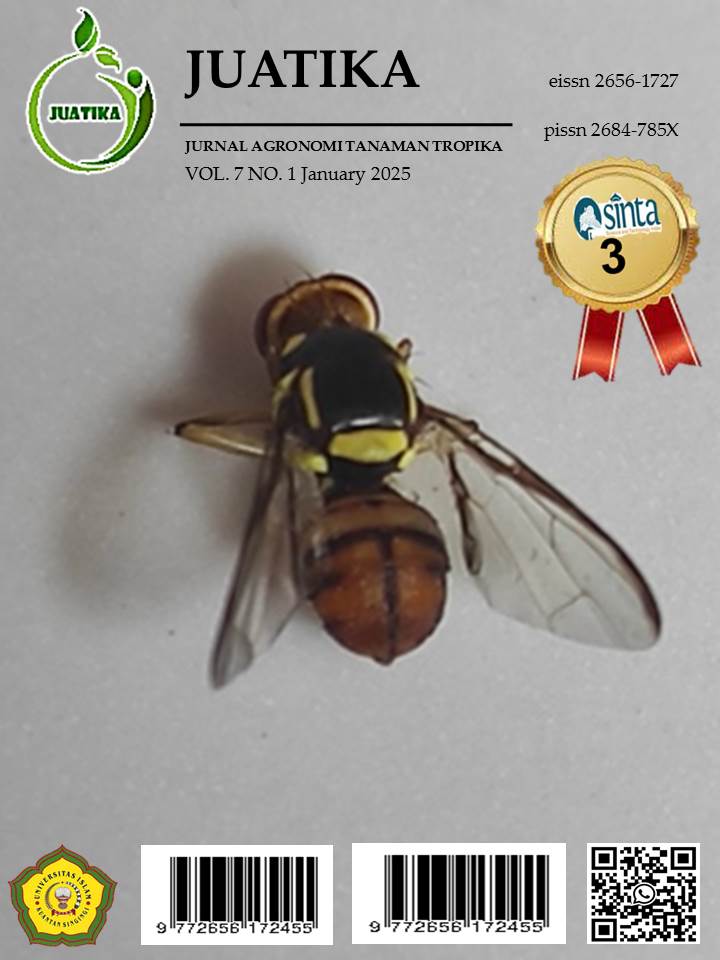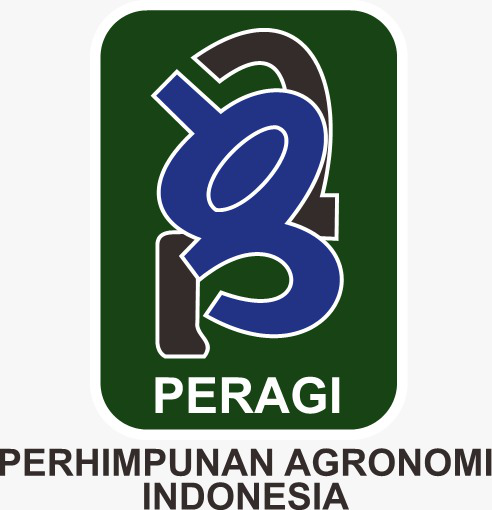The Impact of Implementing Agarwood Agroforestry System (Aquilaria malacensis Lamk.) on Soil Texture, Topsoil Depth, and Water Retention Capacity in Oil Palm Lands (Elaeis guineensis Jacq.)
Abstract
The impact of implementing an agroforestry system in oil palm plantations by integrating agarwood-producing plants (Aquilaria Malacensis Lamk.) with oil palm plants on the physical properties of the soil needs to be assessed. This study is crucial due to the shared land use by agarwood-producing and oil palm plants. The study aims to evaluate the effects of integrating agarwood-producing plants into oil palm plantations on soil physical properties, including soil texture, topsoil depth, and water retention capacity. The research was conducted from September 2024 to November 2024 in agroforestry land (1 ha) and monoculture land (1 ha) in Bukit Kemuning Village, Tapung Hulu Kampar - Riau. The study utilized survey methods and systematic sampling for soil sample collection. The findings indicated that the agroforestry system positively impacted soil physical properties, with improved soil texture (54.67% sandy clay), increased topsoil depth, and enhanced water retention capacity compared to oil palm monoculture land. This improvement can be attributed to the higher organic matter content resulting from the decomposition of agarwood plant litter. Therefore, the agroforestry system enhances soil fertility and promotes sustainable environmental management.
Downloads
References
Badrun, Y., & Mubarak. (2010). Dampak industri perkebunan kelapa sawit terhadap lingkungan global. Seminar dan Lokakarya Revitalisasi dan Penguatan Jenjang Kerjasama Pusat Penelitian Lingkungan Hidup Lembaga Penelitian Universitas Riau, November 2010, 171–179.
Hanafiah, K. A. (1995). Dasar-Dasar Ilmu Tanah. Jakarta: Raja Grafindo Persada.
Haridjaja, O., Baskoro, D. P. T., & Setianingsih, M. (2013). Perbedaan nilai kadar air kapasitas lapang berdasarkan metode Alhricks Drainase Bebas dan Pressure Plate pada berbagai tekstur tanah dan hubungannya dengan pertumbuhan bunga matahari (Helianthus annuus L.). Jurnal Tanah Lingkungan, 15(2), 52–59.
Hardjowigeno, S. (2003). Klasifikasi Tanah dan Pedogenesis. Jakarta: Akademika Pressindo.
Husein, M. F., Mindari, W., & Santoso, S. B. (2023). Dampak pemberian bahan organik dan pasir terhadap sifat fisika tanah Vertisol Bojonegoro. Agro Bali: Agricultural Journal, 6(2), 435–445. https://doi.org/10.37637/ab.v6i2.1176
Janudianto. (2004). Agroforestri dan seresah tanah: Kontribusi bahan organik dalam pengelolaan lahan berkelanjutan. Jurnal Agroforestri Indonesia, 2(1), 45–52.
Jobaggy, E. J., & Jackson, R. B. (2000). The vertical distribution of soil organic carbon and its relationship to climate and vegetation. Ecological Applications, 10(2), 423–436.
Lapadjati, K. K., Wardah, & Rahmawati. (2016). Sifat fisik tanah pada hutan tanaman kemiri, lahan agroforestri, dan lahan hutan sekunder di Desa Labuan Kungguma Kabupaten Donggala Sulawesi Tengah. Jurnal Warta Rimba, 4(2).
Naharuddin, N., Sari, I., Harijanto, H., & Wahid, A. (2020). Sifat fisik tanah pada lahan agroforestri dan hutan lahan kering sekunder di Sub DAS Wuno, DAS Palu. Jurnal Pertanian Terpadu, 8(2), 189–200. https://doi.org/10.36084/jpt.v8i2.251
Nangaro, R. A., Zetly, & Titah, T. (2021). Analisis kandungan bahan organik tanah di kebun tradisional Desa Sereh Kabupaten Kepulauan Talaud. Jurnal Cocos, 3(1), 1–17. https://doi.org/10.35791/cocos.v1i1.321
Risma Sari, M., & Yusmah, R. A. (2023). Penentuan C-organik pada tanah untuk meningkatkan produktivitas tanaman dan keberlanjutan umur tanaman dengan metoda spektrofotometri UV-Vis. Politeknik ATI Padang, 12(1), 11–19. https://doi.org/10.32520/jtp.v12i1.2598
Schenk, H. J. (2008). Soil carbon and nitrogen fractions under different land use practices. Agriculture, Ecosystems & Environment, 126(1-2), 38–45.
Schöning, I., & Kögel-Knabner, I. (2006). The impact of soil depth and land use on the dynamics of soil organic matter. Soil Biology & Biochemistry, 38(7), 1515–1523.
Solekhah, B. A., Priyadarshini, R., & Maroeto, M. (2024). Kajian pola distribusi tekstur terhadap bahan organik pada berbagai penggunaan lahan. Agro Bali: Agricultural Journal, 7(1), 256–265. https://doi.org/10.37637/ab.v7i1.1571
Stevenson, F. J. (1997). Humus Chemistry: Genesis, Composition, Reaction. New York: John Wiley & Sons.
Suryanto, & Wawan. (2017). Pengaruh kemiringan lahan dan Mucuna bracteata terhadap aliran permukaan dan erosi di PT Perkebunan Nusantara V Kebun Lubuk Dalam. JOM (Jurnal Online Mahasiswa), 4. https://jom.unri.ac.id/index.php/JOMFAPERTA/article/view/16770/16194
Tolaka, W., Wardah, & Rahmawati. (2013). Sifat fisik tanah pada hutan primer, agroforestri, dan kebun kakao di Sub DAS Wera Saluopa Desa Leboni Kecamatan Pamona Puslema Kabupaten Poso. Jurnal Warta Rimba, 1(1), 1–8.
Yulina, H., & Ambarsari, W. (2021). Hubungan kadar air dan bobot isi tanah terhadap berat panen tanaman pakcoy pada kombinasi kompos sampah kota dan pupuk kandang sapi. Jurnal Ilmiah Pertanian, 3(2), 1–6.
Young, A. (1997). Agroforestry for Soil Management (2nd ed.). Oxfordshire: CAB International.
Copyright (c) 2025 Feri Agriani, Boris Kaido, Sri Oktika Syahputri, Zakaria

This work is licensed under a Creative Commons Attribution 4.0 International License.
Authors who publish with Jurnal Agronomi Tanaman Tropika (JUATIKA) agree to the following terms:
Authors retain copyright and grant the Jurnal Agronomi Tanaman Tropika (JUATIKA) right of first publication with the work simultaneously licensed under a Creative Commons Attribution License (CC BY 4.0) that allows others to share (copy and redistribute the material in any medium or format) and adapt (remix, transform, and build upon the material for any purpose, even commercially) with an acknowledgment of the work's authorship and initial publication in Jurnal Agronomi Tanaman Tropika (JUATIKA).
Authors are able to enter into separate, additional contractual arrangements for the non-exclusive distribution of the journal's published version of the work (e.g., post it to an institutional repository or publish it in a book), with an acknowledgment of its initial publication in Jurnal Agronomi Tanaman Tropika (JUATIKA). Authors are permitted and encouraged to post their work online (e.g., in institutional repositories or on their website) prior to and during the submission process, as it can lead to productive exchanges, as well as earlier and greater citation of published work.







 More Information
More Information



